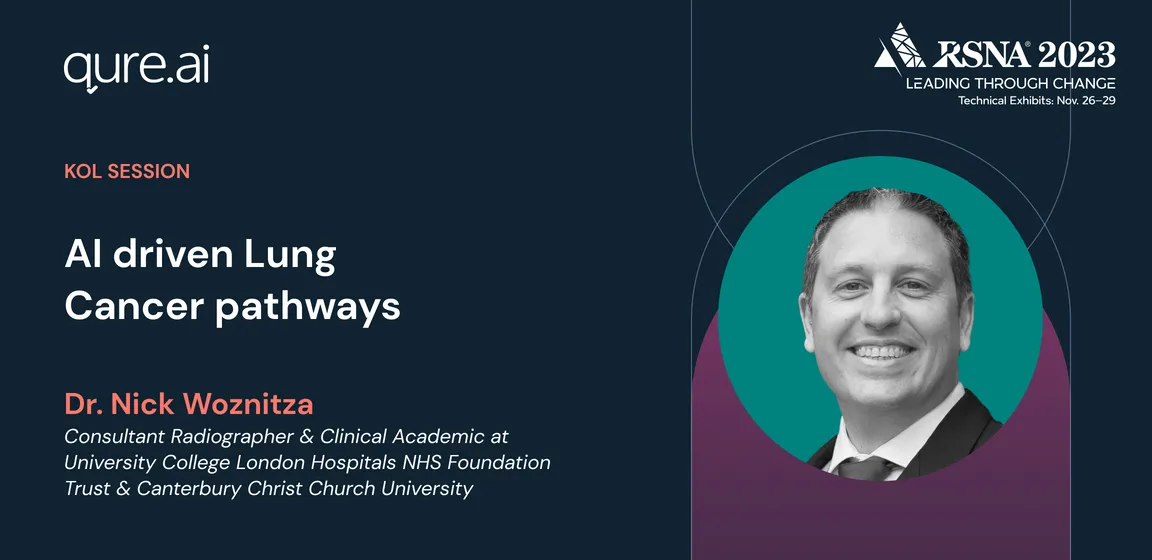Lung cancer continues to be a leading cause of cancer-related deaths worldwide.
Back
It is often detected at advanced stages, significantly diminishing survival rates.
The role of artificial intelligence (AI), particularly Qure.ai's qXR, in early detection and diagnosis is transforming lung cancer pathways, offering new hope for patients and clinicians alike.
The Impact of qXR on Lung Cancer Detection
Qure's qXR, an AI-powered chest X-ray interpretation tool, has demonstrated a profound impact in detecting and localizing lung cancer indicators.
This technology processes hundreds of thousands of chest X-rays (CXRs), accurately flagging potential malignancies.
Remarkably, qXR has identified 90% of missed or mislabeled CXRs with criticalities, showing a sensitivity of 0.96 and specificity of 1.
The technology has processed over 300,000 CXRs across 1,100+ sites, with 7.4% flagged for potential malignancy risk and 27% having high-risk scores.
Qure’s qXR has been pivotal in trials like 'LungIMPACT,' which utilizes qXR for triaging chest X-rays referred by general practitioners (GPs).
This trial aims to identify suspected lung anomalies and provide immediate reporting, showcasing qXR's capability in accelerating diagnosis.
Furthermore, preliminary studies suggest that the Qure system could reduce the time from the first chest X-ray to cancer diagnosis by half, from 60 to 30 days.
Such efficiency in detecting lung irregularities, including cancer, is crucial in streamlining the diagnostic process and improving patient outcomes.
Enhancing Early Detection
Early detection is pivotal in improving lung cancer outcomes.
Over 40% of lung cancer cases are detected at stage 4, with a survival rate under 10%, compared to a 68-92% survival rate when diagnosed at stage 1.
qXR's AI-driven approach significantly enhances the sensitivity and accuracy of lung cancer detection in chest X-rays. Studies have shown a 17% improvement in sensitivity when using qXR compared to traditional radiologist readings.
Additionally, qXR has effectively detected malignant nodules with a sensitivity ranging from 0.95 to 1.00 and an AUC from 0.99 to 1.
qXR's ability to detect and localize up to 30 anomalies, including lung cancer indicators, is highly impactful, especially when large volumes of scans are processed. This capability is especially beneficial in scenarios with a lack of experienced personnel.
Significantly, a reduction of only 15 days in diagnosis time can increase patient survival by 200 days, underscoring the importance of immediate action on suspicious chest X-rays.
This highlights qXR's potential to significantly enhance early detection, thereby improving the 5-year survival rates, which can be as high as 64% if lung cancer is detected at a localized stage.
Global Reach and Collaborations
The collaboration between Qure and AstraZeneca through the Emerging Markets Health Innovation Hubs has been instrumental in integrating AI solutions for early lung cancer detection in diverse regions, including Latin America, Asia, Africa, and the Middle East.
This partnership aims to scale up the use of qXR to improve early-stage detection, reduce mortality rates, and enhance patient outcomes.
The partnership between AstraZeneca and Qure through the Emerging Markets Health Innovation Hubs has been vital in deploying qXR globally.
This collaboration covers various regions, including Latin America, Asia, Africa, and the Middle East, aiming to improve early-stage detection of lung cancer, reduce mortality rates, and enhance patient outcomes.
Further collaborations with organizations like PATH focus on establishing frameworks for early lung cancer diagnosis in low- to middle-income countries, emphasizing this initiative's global scope and Impact.
Innovative Applications and Outcomes
Qure’s qXR effectively detects lung nodules, significantly reduces the time spent per CT scan, and increases inter-reader agreement on Chest CTs. This efficiency is vital in regions with limited access to experienced radiologists or advanced diagnostic tools.
The collaboration with AstraZeneca has led to screening over 80,000 individuals across 20 countries, with plans to screen 5 million patients by 2025.
In addition to its primary function, qXR and the newly introduced qCT-Lung enhance the lung health suite at Qure The AI-powered algorithms in qCT-Lung interpret chest CTs for findings like lung nodules and emphysema, analyzing their malignancy.
The real-world evidence gathered from trials like LungIMPACT underlines the potential of AI-assisted lung cancer diagnosis in saving lives now and in the future. The comprehensive application of qXR across various health settings demonstrates its capability to enhance healthcare practitioners' efficiency at all stages of patient care in lung cancer screenings.
Conclusion
AI-driven pathways, particularly with Qure's qXR, are revolutionizing lung cancer detection and treatment.
By enhancing early detection, reducing diagnostic time, and improving accuracy, qXR sets a new standard in lung cancer care, offering hope for millions worldwide.
Discover these AI-driven advancements in lung cancer care at RSNA 2023. Join Dr. Nick Woznitza at Booth Session 3 on Tuesday, Nov 28, 2023, at 12:30 pm CST for an enlightening session on 'AI-Driven Lung Cancer Pathways.'
Engage with these transformative developments and be part of the future in oncological care.
